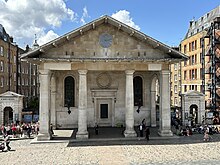
Back كنيسه القديس بولس (مدينه ويستمينستر) ARZ Eglwys Sant Paul, Covent Garden Welsh St Paul’s Church (Covent Garden) German Église Saint-Paul (Covent Garden) French St Paul's, Covent Garden ID Chiesa di San Paolo (Covent Garden) Italian St Paul's, Covent Garden Romanian Церковь Святого Павла в Ковент-Гардене Russian St Paul's (Covent Garden) Slovak 科文特花园圣保罗教堂 Chinese
| St. Paul's, Covent Garden | |
|---|---|
 St Paul's at Covent Garden in June 2023 | |
 | |
| 51°30′41″N 0°7′27″W / 51.51139°N 0.12417°W | |
| Location | Bedford Street, Covent Garden, London |
| Country | United Kingdom |
| Denomination | Church of England |
| Churchmanship | High Church |
| Website | http://www.actorschurch.org/ |
| Architecture | |
| Heritage designation | Grade I |
| Architect(s) | Inigo Jones |
| Years built | 1631–1633 |
| Administration | |
| Diocese | London |
St Paul's Church is a Church of England parish church located in Bedford Street, Covent Garden, central London. It was designed by Inigo Jones as part of a commission for the 4th Earl of Bedford in 1631 to create "houses and buildings fit for the habitations of Gentlemen and men of ability".[1] Initially serving as an auxiliary chapel for the St. Martin-in-the-Fields parish, it was raised to a parish church with a dedication to Saint Paul in 1646, as the Covent Garden district expanded. The church is nicknamed "the actors' church"[2] by a long association with the theatre community, particularly in the West End.
Completed in 1633, St Paul's was the first entirely new church to be built in London since the Reformation.[3] Its design and the layout of the square have been attributed to Inigo Jones since the 17th century, although firm documentary evidence is lacking.[4] According to an often repeated story, recorded by Horace Walpole, Lord Bedford asked Jones to design a simple church "not much better than a barn", to which the architect replied "Then you shall have the handsomest barn in England".[5]

Jones's design closely follows the description of an Etruscan-style temple by Ancient Roman architect Vitruvius,[6] which reflects the early forms of Roman temple. These essentially continued Etruscan architecture, though quite what Vitruvius intended by his account has divided modern scholars.[7] The building is described by Sir John Summerson as "a study in the strictly Vitruvian Tuscan Order" and "almost an archaeological exercise".[8][3] It has been seen as a work of deliberate primitivism: the Tuscan order having been associated by Renaissance architect Palladio with agricultural buildings.[3]
The temple front with a portico on the square has never in fact been the main entrance, although this may have been Jones's first intention. The altar lies behind this wall, and the entrance is at the far end to this. The stone facing of this facade is also later; originally it was apparently brick with stucco. The other sides of the building remain brick, with details in stone. The triangular pediments at both ends are in wood.
- ^ Summerson, John (1966). Inigo Jones. Penguin, 1966. p. 83. Retrieved 23 August 2010.
- ^ "The Actor's Church HOME". actorschurch.org. Retrieved 26 July 2010.
- ^ a b c Cite error: The named reference
pelicanwas invoked but never defined (see the help page). - ^ Cite error: The named reference
surveywas invoked but never defined (see the help page). - ^ Walpole, Horace; Vertue, George (1782). Anecdotes of painting in England. Vol. 2 (3rd ed.). London: J. Dodsley. p. 275.
- ^ Book iv, 7.2-3
- ^ Among other things, it is not clear if Vitruvius was acting as an architectural historian, describing a building type that was no longer newly built by his day, even though his account tells "how to" design such a temple.
- ^ 1st quote from next ref; 2nd quote from Summerson, John (1980), The Classical Language of Architecture, p. 13, 1980 edition, Thames and Hudson World of Art series, ISBN 0-500-20177-3
© MMXXIII Rich X Search. We shall prevail. All rights reserved. Rich X Search